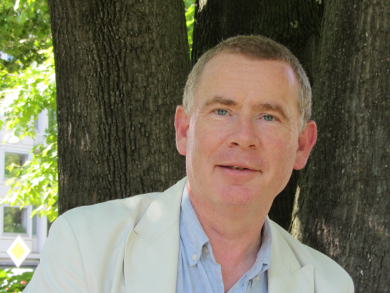Kieron Burke, University of California, Irvine, USA, develops methods for density functional theory (DFT) calculations. He co-developed the popular density functional PBE. In 2014, the corresponding publication [1] was the 16th all-time most cited paper according to Nature, with over 35.000 citations at the time [2]. PBE stands for Perdew, Burke, and Ernzerhof, the three researchers who developed the functional.
Here, he talks to Catharina Goedecke for ChemViews Magazine about his research on using machine learning to create density functionals. DFT calculations help chemists to predict and understand the properties and reactivities of compounds. Machine-created functionals could allow DFT calculations to be performed much faster.
How would you explain density functional theory to a nontheoretician?
It’s a mysterious way to bypass solving the Schrödinger equation directly, making it relatively inexpensive to solve electronic structure problems, but requiring an uncontrolled approximation. It is one of the greatest free lunches ever.
How does a researcher choose which DFT functional to use?
Usually, the user chooses the basis set and the approximate functional. It is straightforward to enlarge the basis set to ensure convergence, i.e., until there is no relevant error from the basis. However, choosing the functional approximation is a delicate art, requiring insight and experience. For routine users, it is best to stick with commonly used functionals, which have relatively well-known limitations.
What is your research focused on?
Improving and extending DFT in chemistry and materials, broadly defined. We work in chemistry, materials science, warm dense matter (a state between condensed matter and hot plasma), molecular electronics, and strongly correlated systems. We use methods from theoretical physics, chemistry, applied mathematics, and computer science. Most of our work includes international collaborators, without whom it would not be possible.
You aim to speed up DFT calculations by bypassing the so-called Kohn-Sham (KS) equations. How does this work?
Most of the computer time in a large DFT calculation is spent solving the Kohn-Sham equations. The equations are based on a hypothetical system in which the electrons don’t interact with each other. This makes the KS equations much easier to solve than the full Schrödinger equation, but they are still differential equations which take a lot of time to solve. The KS equations are constructed using a set of orbitals, and methods that bypass them are called “orbital-free” DFT.
A DFT calculation gives you the density of the system and you figure out the energy from the density. There is a part of the original Hohenberg-Kohn theorem [3] that says there is a map, or a direct assignment, between the potential that the electrons feel due to nuclei and the electron density. In recent work with collaborators at TU Berlin, Germany, and New York University, USA, we bypass the KS equations by using machine learning to get that map directly, without solving any differential equations, which is much, much faster [4].
How much can this approach speed up the calculations?
In molecular dynamics (MD) calculations, for example, the KS equations are solved many, many times during a simulation. In simulations of crack propagation, one might need simulations with 10 million atoms. These simulations are often prohibitively expensive, even on the world’s largest computers. In principle, our machine-learning methods should make these accessible in a fraction of the computer time. However, since we have only done relatively small molecules for relatively short times so far, we have not done any meaningful tests to see how much time we save.
Which chemical systems are particularly problematic for DFT?
The classic example is plotting the potential energy surface of a molecule as one of its bonds is stretched from equilibrium length to infinity, i.e., to a fully broken state. DFT with standard approximations (and many other methods) fails as electrons localize on the different fragments. At best, one ends up with potential energy surfaces with kinks in them, which are highly unsatisfactory for many applications.
What is the idea behind machine learning and how do you use it?
Machine-learning, or ML, is a generic term that covers many different branches of data science. The basic idea behind the ML that I use, named “kernel ridge regression”, is a clever and flexible general method for fitting a function of many variables by training on examples.
Currently, we create a specific functional for a specific molecule, such as water or benzene. We solve the DFT equations for a few situations, which act as “training points” and can, for example, be randomly picked from a molecular dynamics simulation. Then we create the ML functional using this training set, check its accuracy, and finally run long simulations with the ML energies and forces.
The ML density functionals we have created so far are all designed to do things that standard density functional approximations created by humans cannot do. For example, they have no difficulties at all with the bond-breaking I mentioned.
Why is finding new and better functionals such a complex problem?
Our present functionals have been selected over decades for their moderate accuracy for a huge and diverse range of systems and properties. It is often relatively easy to create a functional that does better for a specific property or set of systems, but almost impossible to create new approximations that improve on the old ones without worsening some aspect.
What can computers do better in this context than humans?
Humans are limited by what they can imagine and think about. They cannot build truly complex formulas from more than two or three variables, and require their insight and intuition to guide them. The computer does not need such props to make its deductions, and can succeed where our intuition fails us.
How far has your work progressed and what does still need to be done?
We have now gotten quite far, bypassing the KS equations for MD simulations of simple molecules. But our functionals are still designed for specific systems. The last great hurdle is to create a functional—or at least a procedure—that can be applied to many different systems, and of any size.
What impact could this research have?
Many people have searched for sufficiently accurate approximations to the Kohn-Sham kinetic energy functional for many decades. This field is currently called orbital-free DFT. Success in this area could mean doing DFT simulations with millions of atoms, or running liquid phase molecular dynamics simulations for minutes instead of microseconds. Such capabilities would simply transform the nature of the problems we can address with DFT.
Thank you very much for the interview.
 Kieron Burke studied theoretical physics at Trinity College Dublin, Ireland, and solid-state physics at the University of California, Santa Barbara, USA, where he received his Ph.D. in 1989 under the supervision of Walter Kohn. He worked with David Langreth as a Postdoctoral Fellow at Rutgers University, NJ, USA, until 1991 and then joined Indiana University, Bloomington, IN, USA, as a Research Associate. From 1993 to 1996, Burke worked with John Perdew at Tulane University, New Orleans, LA, USA, as a Research Scientist. He became Assistant Professor of Chemistry at Rutgers University in 1996 and was promoted to Associate Professor in 2002 and to Full Professor in 2005. Since 2006, he is Professor of Chemistry and of Physics at UC Irvine. Last year, he was named Chancellor’s Professor.
Kieron Burke studied theoretical physics at Trinity College Dublin, Ireland, and solid-state physics at the University of California, Santa Barbara, USA, where he received his Ph.D. in 1989 under the supervision of Walter Kohn. He worked with David Langreth as a Postdoctoral Fellow at Rutgers University, NJ, USA, until 1991 and then joined Indiana University, Bloomington, IN, USA, as a Research Associate. From 1993 to 1996, Burke worked with John Perdew at Tulane University, New Orleans, LA, USA, as a Research Scientist. He became Assistant Professor of Chemistry at Rutgers University in 1996 and was promoted to Associate Professor in 2002 and to Full Professor in 2005. Since 2006, he is Professor of Chemistry and of Physics at UC Irvine. Last year, he was named Chancellor’s Professor.
Among other honors, Kieron Burke has received the Bourke Award from the Royal Society of Chemistry in 2017 and the Rutgers Susman Award for Teaching in 2006. He is an Elected Member of International Academy of Quantum Molecular Sciences, a Fellow of the British Royal Society of Chemistry, and a Fellow of the American Physical Society.
References
- [1] Generalized Gradient Approximation Made Simple,
John P. Perdew, Kieron Burke, Matthias Ernzerhof,
Phys. Rev. Lett. 1996, 77, 3865–3868.
DOI: 10.1103/PhysRevLett.77.3865 - [2] The top 100 papers,
Richard Van Noorden, Brendan Maher, Regina Nuzzo,
www.nature.com, October 29, 2014. - [3] Inhomogeneous Electron Gas,
P. Hohenberg, W. Kohn,
Phys. Rev. 1964, 136, B864–B871.
DOI: 10.1103/PhysRev.136.B864 - [4] Bypassing the Kohn-Sham equations with machine learning,
Felix Brockherde, Leslie Vogt, Li Li, Mark E. Tuckerman, Kieron Burke, Klaus-Robert Müller,
Nat. Commun. 2017.
DOI: 10.1038/s41467-017-00839-3
Selected Publications
- Pure density functional for strong correlation and the thermodynamic limit from machine learning,
Li Li, Thomas E. Baker, Steven R. White, Kieron Burke,
Phys. Rev. B 2016.
DOI: 10.1103/physrevb.94.245129 - Understanding machine-learned density functionals,
Li Li, John C. Snyder, Isabelle M. Pelaschier, Jessica Huang, Uma-Naresh Niranjan, Paul Duncan, Matthias Rupp, Klaus-Robert Müller, Kieron Burke,
Int. J. Quantum Chem. 2016, 116, 819–833.
DOI: 10.1002/qua.25040 - Orbital-free bond breaking via machine learning,
John C. Snyder, Matthias Rupp, Katja Hansen, Leo Blooston, Klaus-Robert Müller, Kieron Burke,
J. Chem. Phys. 2013, 139, 224104.
DOI: 10.1063/1.4834075 - DFT in a nutshell,
Kieron Burke, Lucas O. Wagner,
Int. J. Quantum Chem. 2013, 113, 96–101.
DOI: 10.1002/qua.24259 - Perspective on density functional theory,
Kieron Burke,
J. Chem. Phys. 2012, 136, 150901.
DOI: 10.1063/1.4704546 - Finding Density Functionals with Machine Learning,
John C. Snyder, Matthias Rupp, Katja Hansen, Klaus-Robert Müller, Kieron Burke,
Phys. Rev. Lett. 2012.
DOI: 10.1103/physrevlett.108.253002





Professor Burke thanks and congrats for what you have done so far and continue to do in DFT. I am new in the field and would like to know more about machine learning.